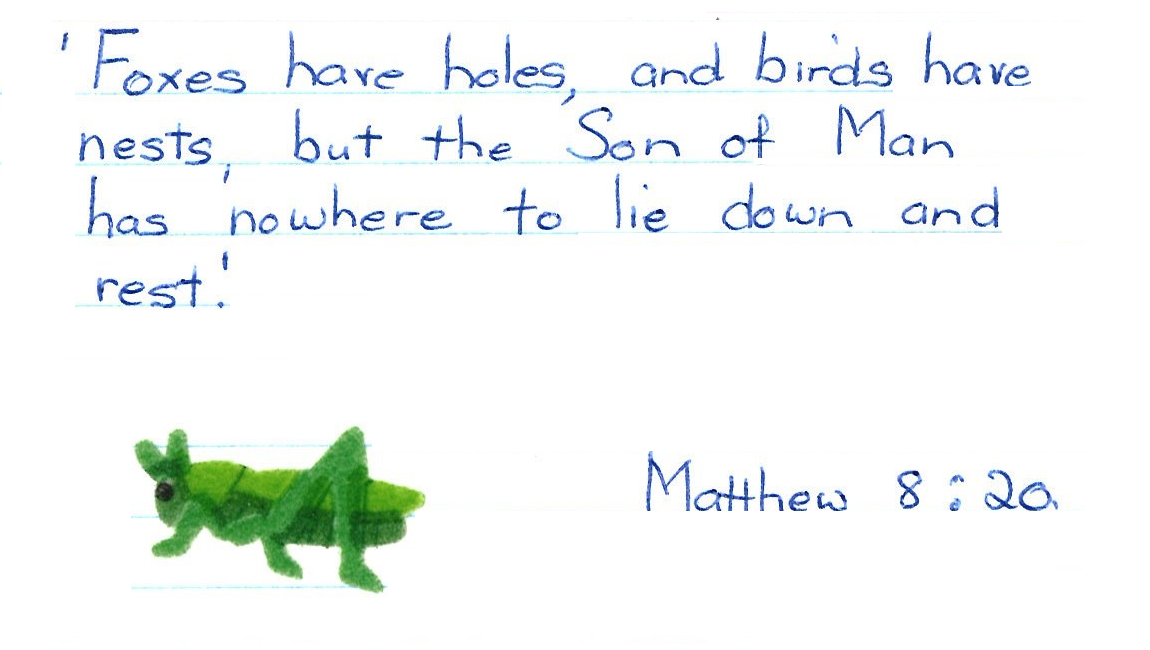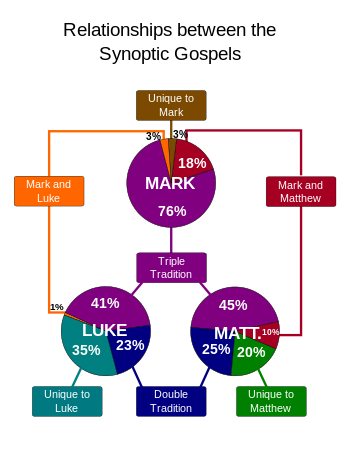
Foxes have holes, and birds have nests, but the Son of Man has nowhere to lie down and rest.
Matthew 8:20 GNB (Good News Bible)
This is the eighth of 20 memory verses that I will use as a guide/focal point to writing these articles. The “Table of Contents” is available here in the series introductory article.
Immediate & Passage Literary Context
The immediate context for this memory verse is Matthew 8:18-22, which is given the passage heading of The Cost of Following Jesus. The following is the NIV extract of these verses:
When Jesus saw the crowd around him, he gave orders to cross to the other side of the lake. Then a teacher of the law came to him and said, “Teacher, I will follow you wherever you go.”
Jesus replied, “Foxes have dens and birds have nests, but the Son of Man has no place to lay his head.”
Another disciple said to him, “Lord, first let me go and bury my father.”
But Jesus told him, “Follow me, and let the dead bury their own dead.”
The memory verse is a direct quote from Jesus, provided in the context of an instruction which focuses on the cost of following Him. Immediately before the verse, Jesus is “challenged” with the prospect of having a teacher of the law becoming his follower. Compared to other translations, the teacher of the law is also referred to as a scribe. His verbal commitment to the Lord is initially noble, but then Jesus highlights the weakness and lack of foresight in the declaration of faith. The style and phrasing of this teacher also suggests the conviction and statement of faith is quite bold and direct.
Sometimes in the heat of the moment, we may form religious convictions. These convictions are not necessarily reliable or thought through. For the scribe/teacher of the law, he felt compelled to declare his allegiance to Jesus and be his follower. Whilst we cannot know the precise motivation behind this action, we do know that Jesus responded somewhat unfavourably by highlighting the dangers and risks that were associated with becoming his follower – there were no guarantees and indeed, the comforts of the previous worldly life would have to be sacrificed in order to join Jesus on his incredibly mobile ministry. Jesus himself had left behind the comforts of his family home back in Capernaum, Galilee and was more or less declaring his own state of poverty and homelessness. Of course, we have the hindsight of reading this passage knowing full well that this earthly perception of vulnerability only adds to the strength and glory of God.
Our Lord’s answer seems to indicate that it was hardly more than the show. The scribe had not considered the true cost, and, like the young ruler that had great possessions, needed to be taught. To follow the Son of Man was not to be the adherent of any particular cause, or be the servant of a king marching onward to an earthly throne, but to share in poverty, deprivation and ultimately homelessness. Consider this in the context of the Lord’s Prayer – Jesus teaches us to seek and thank God for our daily provisions. In the context of Matthew 8:20, the Son of Man is totally dependent on God the Father providing for Him daily in the form of food and shelter.
Indeed, whilst we translate the second phrase as birds have nests, the original Greek word for “nest” has a greater meaning that covers an English equivalence of “shelter”. For a bird, its nest serves for a period in its life known as the brooding season.
Another interesting observation is that according to this Gospel according to Matthew, this is the first recorded instance of the phrase Son of Man, which would become more prominently used. Further, the use of the title Son of Man is almost exclusively used across the four Gospels, in one sense binding them to one another, whilst the Epistles that make of the remainder of the New Testament rarely, if ever, refer to Jesus by that very title. It appears 32 times in Matthew, 14 in Mark, 26 in Luke, and 12 times in John. It is also interesting to observe that use of Son of Man in reference to Jesus was restricted to the time of his three-year earthly ministry.
Wider Literary Context
The Gospel according to Matthew is attributed to Matthew the tax collector, one of the chosen disciples of Jesus. Believed to have been written between 80 – 90AD, the profile of Matthew that we glimpse from the writing style and language suggests a Jew with an education, consistent with the requirements of being a tax collector. Modern scholarship conclude that Matthew drew upon three sources to develop his version of the good news (Gospel):
- Gospel according to Mark
- Collection of sayings (known as the Q Source)
- Unique writings (known as the M Source)
The following diagram, from Wikipedia, summarises the three Synoptic Gospels and how much material within each is shared/sourced from each other.
The structure of Matthew’s Gospel follows five discourses, which scholars believe parallels the Torah being structured as five discourses as well:
- Prologue:
- Genealogy, Nativity & Infancy
- Matthew 1 – 2
- First Discourse:
- Baptism & Sermon on the Mount
- Matthew 3 – 7
- Second Discourse
- Miracles, Discipleship & Commission
- Matthew 8 – 10
- Third Discourse
- Parables & the Kingdom of Heaven
- Matthew 11 – 13
- Fourth Discourse
- Conflicts, Rejection & Disciple Conferences
- Matthew 14 – 18
- Fifth Discourse
- Journey to Jerusalem, Jerusalem & the Olivet Discourse
- Matthew 19 – 25
- Conclusion
- Passion, Resurrection & Great Commission
- Matthew 26 – 28
The audience of Matthew is focused at the Jews since traditions are not explained and become more or less assumed knowledge. Matthew’s main concern was that the Jewish tradition should not be lost in a church increasingly becoming gentile. This motivation was expressed through frequent citations of the Jewish scripture, the evocation of Jesus as the new Moses along with other events from Jewish history, and the concern to present Jesus as fulfilling, not destroying, the Law. In this way, Messianic Jews take great comfort in literature such as the Gospel of Matthew in contrast to the emphasis and focus given by Luke and Paul who’s writings form the later bulk of the New Testament.
Harmonisation of the Gospels, as per this Wikipedia reference/table, actually does not list the key memory verse of Matthew 8:20 as being harmonised across the Gospels, whereas a quick search reveals Luke 9:58 as the cross-reference Gospel harmony. Luke 9:57-60 is the complete passage harmonised with Matthew 8:18-22. In contrast, Luke does not identify the background of the individual who voluntarily offers his service to following Jesus. Matthew did this as part of his reconciliatory outreach to the Jewish community.
The structure of Matthew as outlined above lent itself to being highly conducive for teaching on the life of Jesus. Indeed, it was the most copied, most quoted and most used Gospel during the first two centuries of the early church. Further, for a good millennia until the Renaissance/Reformation it was believed that the Gospel according to Matthew was the first recorded Gospel. The deviation in thought was a direct outcome of the reformation whereby Protestant denominations no longer subscribe to this theory whereas the Catholic Church still upholds this traditional view.
With the appeal to Jews, the placement of Matthew as the first Gospel helped to bridge the Old and New Testaments. Matthew’s reference to the Abrahamic genealogy at the beginning is intentional to help the Jewish readers in affirming the Jewish heritage and identity of Jesus.
Application
When we consider the simple call to action of following Jesus, it is not so straightforward to commit to the challenge. In approaching the topic sensitively and with wisdom, we need to fully appreciate that life does not simply get better or easier because of our faith and commitment to following Jesus. In today’s society, we see the growing persecution of Christians, particularly with the rise of extreme ideologies like ISIS. In one sense, it is groups like this who display an open hostility and brutality towards Christians (amongst the various groups who stand in opposition to their calling) drives home the sacrificial nature and cost which our faith may lead to.


1 comment
Comments are closed.